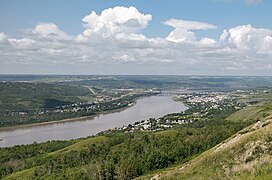| Boreal Plains | |
|---|---|
 Peace Lowland ecoregion of the Boreal Plains ecozone | |
| Ecology | |
| Borders | |
| Geography | |
| Area | 737,287 km2 (284,668 sq mi) |
| Country | Canada |
| Provinces | |
| Climate type | Humid continental and subarctic |
The Boreal Plains Ecozone, as defined by the Commission for Environmental Cooperation (CEC), is a terrestrial ecozone in the western Canadian provinces of Manitoba, Saskatchewan and Alberta. It also has minor extensions into northeastern British Columbia and south-central Northwest Territories.[1][2] The region extends over 779,471 km2, of which 58,981 km2 is conserved (7.6 percent).[3]
Wood Buffalo National Park, the largest national park in Canada, and Whooping Crane Summer Range, the only nesting and breeding area for the critically endangered whooping crane, are both located in the northern portion of this ecozone.[4]
Industry in this ecozone once consisted primarily of forestry and agriculture, but in 1967 Great Canadian Oil Sands Limited began extracting bitumen from the Athabasca oil sands. Operations there have expanded significantly since 2003, and the oil sands are becoming an increasingly significant economic factor in the region.
- ^ "Terrestrial Ecozones of Canada". Teacher Resource Centre. Parks Canada. Retrieved 2016-05-14.
- ^ "Ecozones – Maps (2014)". Canadian Council on Ecological Areas (CCEA). Retrieved 12 August 2017.
- ^ Canada, Environment and Climate Change (9 February 2010). "Canada's conserved areas - Canada.ca". www.canada.ca. Retrieved 26 October 2018.
- ^ "Wood Buffalo National Park". indicators-map.canada.ca. Government of Canada. Retrieved 26 October 2018.